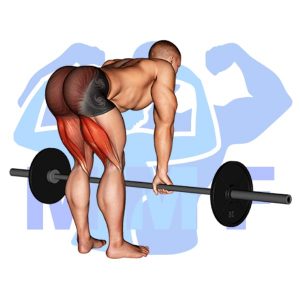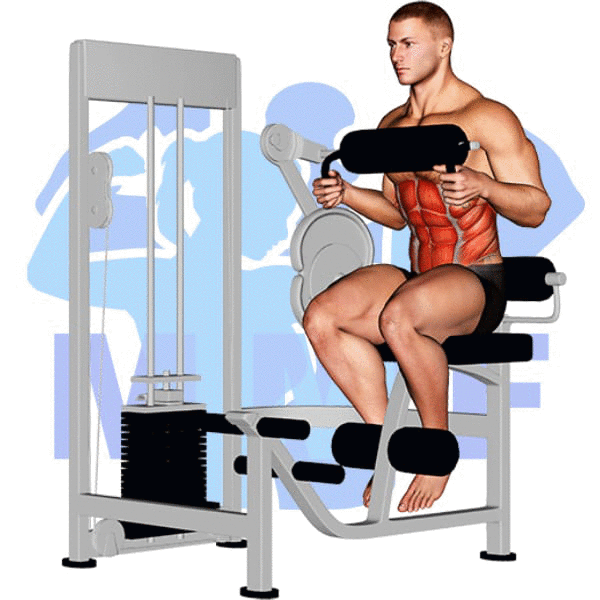Do you struggle with achieving proper form during the barbell Olympic squat? You’re not alone. Many people find it challenging to squat correctly while using a barbell. The reason for this is often due to poor ankle mobility and limited range of motion in the hips. However, don’t fret, there are solutions to this problem. In this blog post, we will provide some helpful tips and tricks to improve your barbell Olympic squat form and help you get the most out of your workouts.
Barbell Olympic Squat Summary
- Primary Muscles: Quadriceps
- Secondary Muscles: Adductor Magnus, Gluteus Maximus, and Soleus
- Equipment: Barbell
- Mechanics Type: Compound
- Force: Push
- Utility: Basic

Barbell Olympic Squat Instructions
- The Olympic Squat is a high bar squat with the bar resting on the top of your Trapezious.
- To get a good starting position set up under the bar and grab the bar outside of your shoulders.
- Now, flex your traps by pulling the your hands together, but not actually having your hands move. This should set a good base on your traps to rest the bar.
- Next un-rack the bar and step into position with a stance where your feet are directly under your hips, knees and feet slightly pointed out.
- You are ready to squat down all the way until your hip joint is lower than the top of your knee. Do this by pivoting your hips and knees together, moving the bar in a vertical line.
- Then explode back up to the top then do it again. You have to love Olympic squats.
Video Tutorial
Barbell Olympic Squat Muscles
Target (Agonist)
Synergists
- Adductor Magnus
- Gluteus Maximus
- Soleus
Dynamic Stabilizers
Stabilizers
- Erector Spinae
- Levator Scapulae
- Trapezius – Middle
- Trapezius – Upper
Antagonist Stabilizers

Benefits of Barbell Olympic Squat
The Barbell Olympic Squat is a great exercise to include in a strength training or fitness routine, as it helps to build muscle and strength in the quadriceps. This exercise specifically works the quads, glutes, hamstrings, and core muscles. It increases balance, coordination, and stability, as well as power and explosiveness. The barbell Olympic squat can also help to improve posture and mobility, and will help to prevent injury. Furthermore, this exercise can help to build overall lower body strength. Performing barbell Olympic squats can help to increase muscle mass and tone the quadriceps, making them stronger and more defined.
Tips for Performing Barbell Olympic Squat
. The Barbell Olympic Squat is a great exercise for building strength, balance, and flexibility. To get the most out of this exercise, it is important to understand proper form and technique. Below are some simple tips that you can use to get the most out of your Barbell Olympic Squat.
- Perform Good Warm Up Prior To You Begin To Add Your Weight. Not suitably doing a warmup doing a proper warm up is the leading cause of injuries.
- Stay Hydrated. You will recover faster and even more energy when you consume water while exercising.
- Execute At Least 3 Of 8-20 Reps For Muscle Growth. Now there are several theories on how Muscle Growth is induced, most agree with the fact that sets using 60-80% of your respective 1RM are going to resulted in increased muscle size.
- conduct your large compound exercises near the beginning of your workout, next perform isolation exercises to focus on single muscle groups afterward. You need the optimum capabilities of your individual muscle groups any time you accomplish compound movements, for instance, deadlifts, squats, and bench. Then you need to focus on the muscle zones that you determined were weak in those movements or zones that couldn’t get fatigued as a result of the type of compound exercise you executed.
- To Focus On Speed And Power, Bring Up The Velocity Of Your Movements. Continue to keep excellent form or you will be more suboptimal to personal injury. You ought to reduce the weight to 50 to 60 percent of your one-rep max when training for quickness. However, you will need to pause in between every repetition.
Benefits and Tips Video
Frequent Mistakes To Avoid
The Barbell Olympic Squat is an effective way to build strength and get fit, but it’s important to do the exercise correctly. To help you do that, here is a list of mistakes to avoid when performing the Barbell Olympic Squat.
- Avoid The Urge To implement poor form. Improper technique is normally the fast path to obtain a personal injury.
- You Can’t Perform The Exact Same Exercises Every Moment. Any time you execute the exact exercise every work out ones muscular tissues is likely to be conditioned to complete that sole physical exercise very well, and you will peak a lot quicker.
- Don’t Relax Your Core. Keeping your core flexed to protect your spinal column by maintaining your internal pressure.
Find More Barbell Exercises Here
Variations and Complementary Exercises
If you’re looking to change up your routine and challenge yourself, there are several variations, complementary, and alternative exercises for the Barbell Olympic Squat that you can try. These exercises will work similar muscles as the Barbell Olympic Squat and will help you take your workout to the next level. Below is a list of some of these exercises:
Barbell Quarter Squat

The Barbell Quarter Squat is a great complementary or alternative exercise to the Barbell Olympic Squat. It involves performing a quarter squat while holding a barbell at shoulder height. The movement targets the same muscles as the full Olympic Squat, but with less range of motion. This makes it an ideal exercise for those who are just starting out with strength training, as it allows them to build up their strength and stability without having to perform a full range of motion squat. Additionally, it can be used as an accessory exercise to the Olympic Squat for advanced lifters who want to increase their strength in the bottom portion of the movement.
Barbell Squat to Shoulder Press

The Barbell Squat to Shoulder Press is an excellent complementary or alternative exercise to the Barbell Olympic Squat. It is a compound exercise that not only strengthens the lower body but also targets the upper body. To perform this exercise, start in a standing position with a barbell on your shoulders. Lower yourself into a squat position, then drive back up and press the barbell up towards the ceiling. This exercise works both the lower body and upper body at the same time and helps to build strength, endurance and power. It can be used as an alternative exercise to the Barbell Olympic Squat for a full-body workout.
Barbell Sumo Squat

The Barbell Sumo Squat is a great alternative or complementary exercise to the Barbell Olympic Squat. This variation of the squat places your feet wider than shoulder-width apart and your toes slightly pointed outward. It also requires you to push your hips back and down while keeping your chest up and core tight. This exercise is great for strengthening your quads, glutes, hamstrings, and core. Additionally, it will help with your balance and flexibility as well as recruiting more muscles than the traditional Barbell Olympic Squat.
Check Out These Top Barbell Exercises
Barbell Zercher Squat

The Barbell Zercher Squat is a great alternative or complementary exercise to the Barbell Olympic Squat. This exercise primarily works the quads, glutes, and core, but also engages the lats, traps, and upper back. The unique aspect of this exercise is that the barbell is held in the crook of the elbow, rather than on the back or shoulders. This position places much of the load on the anterior core muscles, making it an excellent core strengthening exercise. Additionally, by changing the load position from traditional back squats, the Zercher squat can reduce stress on the lower back and allow for greater quadriceps development.
Bulgarian Half Squat With Band

The Bulgarian Half Squat with Band is a great alternative to the Barbell Olympic Squat, as it requires less weight and allows for a larger range of motion. This exercise works the glutes, quadriceps, and hamstrings, while providing stability in the ankle, knee, and hip joints. The band adds resistance to the exercise, and helps to increase the intensity of the squat. Additionally, it can be done at home or in the gym, making it a great alternative for those who don’t have access to a barbell.
Dumbbell Half Squat

The Dumbbell Half Squat is an effective, complementary exercise to the Barbell Olympic Squat. This exercise targets the same muscle groups as the Barbell Olympic Squat, but uses only one dumbbell. The weight can be varied depending on the desired intensity, making it an ideal alternative for those who cannot lift heavy barbells. This exercise also increases stability and balance, and can be done in a variety of stances such as a narrow or wide stance, or with a staggered stance.
Find More Legs Exercises Here
Opposing Complementary Exercises
Complementary exercises are important for any workout, and the Barbell Olympic Squat is no exception. In order to strengthen the muscles used in this exercise and to ensure balanced muscle growth, it is recommended to include exercises that work the opposing muscle groups. Here is a list of exercises that do just that:
Barbell Dimmel Deadlift

The Barbell Dimmel Deadlift is a great complementary exercise to the Barbell Olympic Squat as it works the opposing muscle group. This exercise is a variation of the traditional deadlift and can be used to increase strength and muscle development in the glutes, hamstrings, lower back and core. The Dimmel Deadlift focuses on engaging the posterior chain of muscles and helps to balance out the development of the quadriceps, which are heavily engaged during an Olympic Squat. The Dimmel Deadlift is an excellent way to ensure that all muscles involved in the squatting motion are adequately worked and developed.
Barbell Snatch Deadlift

The Barbell Snatch Deadlift is a complementary exercise to the Barbell Olympic Squat because it works the opposing muscle groups. This exercise targets the posterior chain, which includes the glutes, hamstrings, and lower back muscles, while the Barbell Olympic Squat focuses on the quadriceps, hips, and core. The Barbell Snatch Deadlift also improves balance and stability by strengthening the entire posterior chain. By alternating between these two exercises, athletes can build strength and power while also increasing muscle size and improving overall fitness.
Barbell Straight Leg Deadlift

The Barbell Straight Leg Deadlift is a great exercise to complement the Barbell Olympic Squat as it works the opposing muscle group. This exercise focuses on the hamstrings, glutes, and lower back muscles, while the Barbell Olympic Squat works the quadriceps, hip flexors, and glutes. By performing both exercises, you are ensuring that all of the major muscle groups in the lower body are being targeted and strengthened. The Barbell Straight Leg Deadlift also helps improve balance and stability, two important elements for any athlete or fitness enthusiast.
Perfect Your Squat Form Today!
To get the most out of your barbell Olympic squat, perfecting your form is a must. A proper squat involves engaging all the muscles in your lower body, including your glutes, quadriceps, and hamstrings, while keeping your core tight and your chest up. It is also important to maintain proper alignment with your spine, knees, and ankles to prevent injury. Remember that good form will not only help you avoid injury, but it will also allow you to lift heavier weights and get better results from your workout.
References: Wikipedia | ExRx.net | PubMed.gov | Comprehensive List of Legs Barbell Exercises




